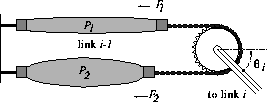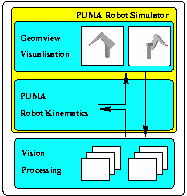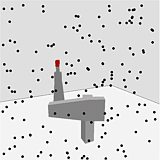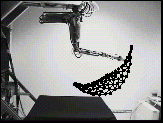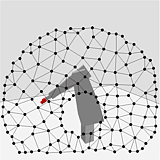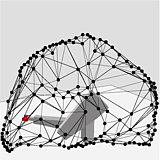Research Topics - Neurobiology
Concerned with both central and peripheral nervous system in living organisms, the field of neurobiology includes explorations into the structure, function, development, biochemistry, physiology and pathology of the nervous system, with the level of analysis ranging from molecular through cellular levels of analysis. At the Theoretical and Computational Biophysics Group, research topics have included the use of neural networks to control motor movement, including visuo-motor control (based on models of the visual cortex and studies of its development) and applicability of neural network concepts to control robotic arms.
The SoftArm is modeled upon the human arm and has four joints resulting in five degrees of freedom. It exhibits the essential mechanical characteristics of skeletal muscle system by means of agonist-antagonist pairs of rubbertuators which are mounted on opposite sides of rotating joints.
Our simulator environment is intended for flexible testing and implementation of neural network control methods, e.g., to test the sensor-based motion planning approach we developed on our pneumatic robot system. Furthermore, the simulator allows one to define arbitrary camera positions and to visualize the robot motion in 3D. The design of the robot simulator is based on parallel distributed processing and socket-based interprocess communication which allows the different modules of the simulator to run in parallel on a network of workstations.
Movement of higher biological organisms is the result of information processing in a complex hierarchy of motor centers within the nervous system. To date, there is still no general consensus about how biological neural networks actually generate voluntary movement. Neurophysiological studies, on one side, provide the essential data on which a top down modelling approach can be based.
A very important step towards autonomous robotics is developing ways to generate motion plans for achieving certain goals while satisfying environmental constraints. Classical motion planning is defined on a configuration space which is assumed to be known, implying the complete knowledge of both the robot kinematics as well as knowledge of the obstacles in the configuration space. On the other hand, vision-based, or more general, sensor-based path planning provides a more practical approach to robot control. To best utilize the sensor feedback, a robot motion plan should incorporate constraints from the sensor system as well as criteria for optimizing the quality of the sensor feedback. We therefore combined a novel approach to robot motion planning, based on the concept of the Perceptual Control Manifold (PCM) with a Topology Representing Network (TRN) architecture.
After the topology preserving map of a given input manifold M has been established, we want to generate a path from any initial position to a given target, e.g., to guide an end effector of a robot manipulator in the presence of obstacles within the workspace. We propose to use for this purpose a diffusion-based path finding algorithm on the discrete network lattice in which the target neuron is the source of a diffusing substance.
The Theoretical Biophysics Group has expended a significant amount of effort in direct collaboration with experimentalists. Two such projects connected with neurobiology were studies of the function of visual maps in the cortex and the morphogenesis of the Lateral Geniculate Nucleus (LGN) in primates. An understanding of these systems will allow us to comprehend the formation and function of neural maps, addressing the fundamental issue of how stimuli are interpreted.

